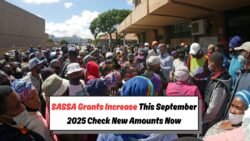Discover the September 2025 SASSA Beneficiary List: The South African Social Security Agency (SASSA) has once again rolled out its monthly disbursement to eligible citizens, offering critical financial support to those in need. In September 2025, the agency confirmed a payout of R3,070 to a wide range of beneficiaries scattered across the nation. As the economic landscape continues to fluctuate, this financial aid serves as a vital lifeline for millions of South Africans grappling with daily expenses. Understanding who qualifies for these payments, and the impact it has on the broader community, provides a clearer picture of the social welfare landscape in South Africa.

Eligibility Criteria for the SASSA September 2025 Payout
Understanding the eligibility criteria for the September 2025 SASSA payout is crucial for those seeking to benefit from this monthly financial aid. The South African Social Security Agency has established specific guidelines to ensure that the funds are distributed to those who need them most. Primarily, the beneficiaries include the elderly, individuals with disabilities, and families struggling below the poverty line. To qualify, applicants must provide documented proof of their financial status and residency within South Africa. Additionally, the agency requires that applicants do not receive any other form of substantial income that could affect their eligibility. This stringent vetting process helps maintain the integrity of the distribution system, ensuring that the R3,070 payout reaches those truly in need. These criteria are designed not only to assist individuals but also to alleviate the financial burden on families, thereby promoting overall economic stability within the community.
Impact of the R3,070 Payout on South African Households
The R3,070 payout from SASSA in September 2025 has had a transformative impact on many South African households, offering much-needed relief in a challenging economic climate. For many families, this payout represents the difference between making ends meet and facing financial hardship. The funds are typically used for essential expenses such as groceries, utilities, and healthcare, which are critical components of maintaining a basic standard of living. Moreover, this financial support is particularly significant in rural areas where access to employment opportunities is limited, and poverty rates are higher. By providing a steady source of income, the SASSA payout helps mitigate the effects of unemployment and underemployment, offering a semblance of stability to families struggling to cope with the rising cost of living. The broader economic impact is also notable, as increased consumer spending contributes to local businesses and stimulates economic activity.
Challenges Faced by SASSA in Distributing the September 2025 Payout
The distribution of the September 2025 payout by SASSA has not been without its challenges. One of the primary hurdles has been ensuring timely and accurate disbursement to all eligible beneficiaries. The sheer volume of applications and the vast geographical spread of recipients require a well-coordinated logistical effort. SASSA has faced issues related to outdated information systems and the need for modernization to handle the growing demand efficiently. Furthermore, remote areas often present difficulties in reaching beneficiaries, leading to delays in payment processing. The agency also contends with fraudulent claims, which necessitate stringent verification processes to protect the integrity of the system. Despite these challenges, SASSA continues to work diligently to improve its operations, striving to deliver financial aid promptly and securely to those who rely on it for their daily livelihoods.
Future Outlook for SASSA Payouts Beyond September 2025
Looking beyond September 2025, the future outlook for SASSA payouts remains a topic of significant interest and speculation. As economic conditions evolve, there is ongoing debate about the adequacy of the current payout amounts and the need for potential adjustments to keep pace with inflation and cost-of-living increases. Policymakers and social welfare advocates are continuously assessing the effectiveness of the existing social grant system, with considerations for expanding the scope of beneficiaries or introducing additional support measures. Technological advancements are also expected to play a role in improving the efficiency and reach of the payout distribution. Innovations such as digital payment platforms and enhanced data management systems could streamline the process, making it more accessible and secure for beneficiaries. As South Africa navigates its socio-economic challenges, the role of SASSA payouts in providing a safety net for vulnerable populations will undoubtedly remain a focal point of national discourse.



